List of reptiles of Michigan facts for kids
Michigan is a state in the United States that is home to many amazing animals! You can find two types of lizards, nineteen types of snakes, and eleven types of turtles living here. All of these animals belong to a group called reptiles.
Reptiles live all over Michigan. However, the only venomous (poisonous) snake, the eastern massasauga rattlesnake, is only found in the southern part of Michigan, called the Lower Peninsula. Reptiles are "cold-blooded," which means their body temperature changes with the temperature around them. Because Michigan winters are very cold, reptiles usually spend this time in warm, safe places. Snakes and land turtles might hide in burrows, while water turtles stay at the bottom of lakes and streams.
Most reptiles in Michigan are protected by state laws. But many are still in danger because people are building homes and cities where reptiles used to live. Also, wetlands (swampy areas) are being drained, which takes away reptile homes. Sadly, some people also kill snakes because they are afraid of them. In 1995, the painted turtle became Michigan's official state reptile!
Contents
Where Reptiles Live in Michigan
Michigan's reptile homes, called habitats, are usually divided into four main areas. These areas are different because of their climate (weather), soil, and how the land was formed by glaciers long ago.
Southern Lower Peninsula
This area has warmer, more stable weather. The soil is mostly loam and clay, which are good for plants, with some sand. You'll find many leafy trees (like oak and maple) here, along with some natural prairies (grasslands) and savannas (grasslands with scattered trees). This region has the most types of plants and animals, including some that don't live anywhere else in Michigan.
Northern Lower Peninsula
This part of Michigan is cooler and has more changing weather. It gets more rain because it's close to the Great Lakes. There are more hills and it's further north. The soil is mostly sandy with glacial deposits (rocks and dirt left by glaciers). You'll see lots of conifer (pine) trees or a mix of pine and leafy forests. Swamps and bogs (wet, spongy areas) are more common here than in the southern part.
Eastern Upper Peninsula
The weather here is similar to the northern Lower Peninsula. The soil is mostly sand and clay, which doesn't have many nutrients and doesn't drain water well. There are huge wetlands with many pine forests. Higher areas have mixed pine and leafy forests.
Western Upper Peninsula
This region has many large rock formations. The weather changes a lot, with very cold winters and hot summers. Again, you'll find a mix of pine and leafy forests.
Protecting Michigan's Reptiles
Some reptiles in Michigan are in serious trouble. Three species are considered threatened, meaning they could become endangered soon. Two species are endangered, meaning they are at high risk of disappearing forever. These endangered species are protected by Michigan's Endangered Species Act.
Six more species are of "special concern." This means they might need protection in the future, but they aren't protected by the act yet. The copperbelly water snake is listed as threatened by the US government. The eastern massasauga rattlesnake might soon be added to the US endangered species list.
Lizards of Michigan
Michigan has two types of lizards.
| Scientific name | Common name | Description | Image | Notes |
|---|---|---|---|---|
| Cnemidophorus sexlineatus | Six-lined racerunner | Adults are about 6 to 10.5 inches (15 to 27 cm) long. They are olive, gray, brown, or black with six lighter stripes. | 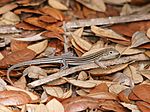 |
Only found in Tuscola County in eastern Michigan. This lizard is a threatened species. |
| Plestiodon fasciatus | Five-lined skink | Adults can be up to 8.5 inches (22 cm) long. They are gray-brown or dark brown with five white or cream stripes. |  |
Snakes of Michigan
Michigan is home to nineteen types of snakes. Most of them are harmless!
| Scientific name | Common name | Description | Image | Notes |
|---|---|---|---|---|
| Clonophis kirtlandii | Kirtland's snake | Adults are 12 to 18 inches (30 to 46 cm) long. They are reddish-brown with black blotches and a black head. This snake is not venomous. |  |
This snake is an endangered species in Michigan. |
| Coluber constrictor foxii | Blue racer | Adults are 4 to 6 feet (1.2 to 1.8 m) long. They are gray or blue. This snake is not venomous. |  |
|
| Diadophis punctatus edwardsii | Northern ring-necked snake | Adults are 10 to 24 inches (25 to 61 cm) long. They are black or gray with a yellow belly and a yellow ring around their neck. This snake is not venomous. |  |
|
| Pantherophis gloydi | Eastern fox snake | Adults are 3 to 5 feet (0.9 to 1.5 m) long. They are yellow or light brown with dark splotches. This snake is not venomous. |  |
This snake is a threatened species in Michigan. |
| Pantherophis vulpina | Western fox snake | Adults are 3 to 5 feet (0.9 to 1.5 m) long. They are yellow or light brown with dark splotches. This snake is not venomous. | 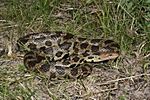 |
|
| Heterodon platirhinos | Eastern hog-nosed snake | Adults are 20 to 40 inches (51 to 102 cm) long. Their colors and patterns vary a lot, from yellow to black. This snake is not venomous. |  |
|
| Lampropeltis triangulum triangulum | Eastern milk snake | Adults are 2 to 4 feet (0.6 to 1.2 m) long. They are gray or tan with red or brown blotches. This snake is not venomous. | 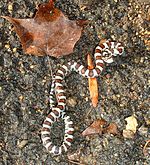 |
|
| Liochlorophis vernalis | Smooth green snake | Adults are 12 to 20 inches (30 to 51 cm) long and bright green. This snake is not venomous. | 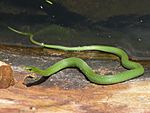 |
|
| Nerodia erythrogaster neglecta | Copperbelly water snake | Adults are 4 to 5 feet (1.2 to 1.5 m) long. They are dark brown or black with a red or orange underside. This snake is not venomous. |  |
This snake is a threatened species by the US government and an endangered species in Michigan. |
| Nerodia sipedon | Northern water snake | Adults are 2 to 4 feet (0.6 to 1.2 m) long. They are light brown or gray with dark bands or splotches. This snake is not venomous. |  |
|
| Pantherophis obsoletus | Black rat snake | Adults are 3.5 to 8 feet (1.1 to 2.4 m) long and black. This snake is not venomous. |  |
|
| Pantherophis spiloides | Gray rat snake | Adults are usually 3 to 5 feet (0.9 to 1.5 m) long. They are gray with darker blotches. This snake is not venomous. |  |
This snake is a species of special concern in Michigan. |
| Regina septemvittata | Queen snake | Adults are 15 to 36 inches (38 to 91 cm) long. They are gray or brown with a light stripe on each side of their body. This snake is not venomous. |  |
This snake is a species of special concern in Michigan. |
| Sistrurus catenatus catenatus | Eastern massasauga rattlesnake | Adults are 2 to 3 feet (0.6 to 0.9 m) long. They are gray or brown with dark brown patches. This is the only venomous snake in Michigan. |  |
This snake is being considered for the federal endangered species list and is a species of special concern in Michigan. |
| Storeria dekayi | Brown snake | Adults are 9 to 15 inches (23 to 38 cm) long. They are brown or gray with a light stripe down their back, bordered by dark spots. This snake is not venomous. |  |
|
| Storeria occipitomaculata occipitomaculata | Red-bellied snake | Adults are 8 to 16 inches (20 to 41 cm) long. They are brown or gray with a reddish underside. This snake is not venomous. | 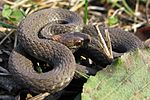 |
|
| Thamnophis butleri | Butler's garter snake | Adults are 15 to 27 inches (38 to 69 cm) long. They are black, brown, or olive with three yellow stripes along their body. This snake is not venomous. |  |
|
| Thamnophis saurita septentrionalis | Northern ribbon snake | Adults are 18 to 38 inches (46 to 97 cm) long. They are black or brown with three yellow stripes along their body. This snake is not venomous. |  |
|
| Thamnophis sirtalis | Eastern garter snake | Adults are 2 to 4 feet (0.6 to 1.2 m) long. They are gray, brown, or green with three yellow stripes along their body. This snake is not venomous. | 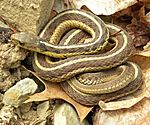 |
Turtles of Michigan
You can find eleven different types of turtles in Michigan.
| Scientific name | Common name | Description | Image | Notes |
|---|---|---|---|---|
| Apalone spinifera spinifera | Spiny soft-shell turtle | Adults are 5 to 19 inches (13 to 48 cm) long. They are olive or brown with dark spots. | 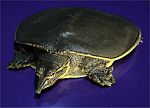 |
|
| Chelydra serpentina | Common snapping turtle | Adults are 8 to 19.3 inches (20 to 49 cm) long. They are gray, brown, or olive. |  |
|
| Chrysemys picta bellii | Western painted turtle | Adults are 4 to 9.8 inches (10 to 25 cm) long. They are black or olive with red and yellow markings and a colorful underside. This type has a narrow dark blotch on its underside. | 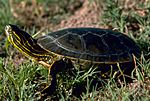 |
|
| Chrysemys picta marginata | Midland painted turtle | Adults are 4 to 9.8 inches (10 to 25 cm) long. They are black or olive with red and yellow markings and a colorful underside. This type has a wide dark blotch on its underside. |  |
|
| Clemmys guttata | Spotted turtle | Adults are 3.5 to 5 inches (8.9 to 13 cm) long. They are black with yellow spots. |  |
This turtle is a threatened species in Michigan. |
| Emys blandingii | Blanding's turtle | Adults are 6 to 10.75 inches (15 to 27 cm) long. They are black with yellow speckles. |  |
This turtle is a species of special concern in Michigan. |
| Glyptemys insculpta | Wood turtle | Adults are 6.3 to 9.4 inches (16 to 24 cm) long. They are brown and have a shell that looks like it's carved or sculpted. |  |
This turtle is a species of special concern in Michigan. |
| Graptemys geographica | Common map turtle | Adults are 4 to 10.7 inches (10 to 27 cm) long. They are green, olive, or brown with yellow markings and underside. |  |
|
| Sternotherus odoratus | Common musk turtle | Adults are 3.25 to 5.37 inches (8.3 to 13.6 cm) long. They are black or brown and often have algae growing on their shell. |  |
|
| Terrapene carolina carolina | Eastern box turtle | Adults are 4.5 to 7.8 inches (11 to 20 cm) long. They are dark with yellow or orange patterns. |  |
This turtle is a species of special concern in Michigan. |
| Trachemys scripta elegans | Red-eared slider | Adults are 5 to 11 inches (13 to 28 cm) long. They are green or brown with yellow and black markings, and a clear red stripe behind each eye. | 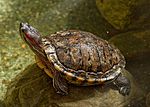 |
These turtles are not native to Michigan. They were likely brought here as pets. |
See also


